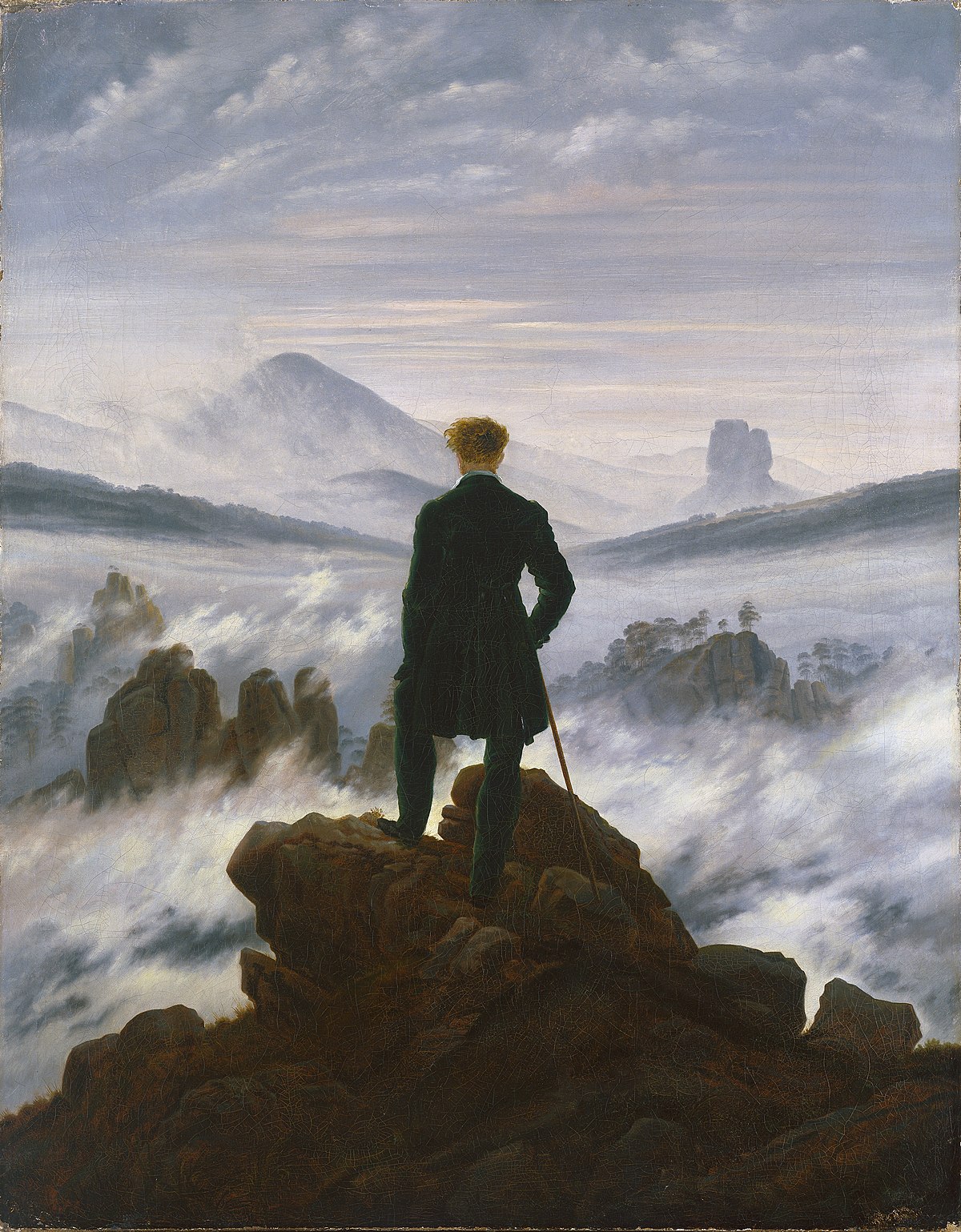
Nestled within the annals of art history is a masterpiece that transcends time and space — “The Wanderer above the Sea of Fog” by Caspar David Friedrich. Painted in 1818 during the height of German Romanticism, this iconic artwork beckons viewers into a realm where the ethereal meets the tangible. In this simple introduction, we embark on a contemplative exploration of the painting, unraveling its historical context, artistic nuances, and the profound impact it has left on the canvas of cultural consciousness. Join us as we navigate the fog-laden landscape and delve into the layers of meaning woven into the fabric of this timeless masterpiece.
Title and Artist: “The Wanderer above the Sea of Fog” is an iconic masterpiece that emerged from the creative mind of the German Romantic artist Caspar David Friedrich in 1818. The title encapsulates the essence of the painting, emphasizing both the solitary figure’s act of wandering and the mysterious, ethereal sea of fog that envelopes the landscape.
Art Movement: This captivating artwork is a hallmark of the German Romanticism movement, a cultural and intellectual wave that swept through Europe in the late 18th to mid-19th centuries. German Romanticism rejected the rationality of the Enlightenment era, championing instead the individual’s emotional experience and the sublime beauty found in nature.
Genre: “The Wanderer above the Sea of Fog” falls within the genre of landscape painting, a prevalent theme in Caspar David Friedrich’s body of work. Landscape painting during the Romantic period served as a powerful means of expressing the artist’s connection to the natural world and often carried symbolic significance.
Composition: The composition of this painting is nothing short of sublime. The viewer is drawn into a world where a lone, contemplative figure stands on a rocky precipice, overlooking a vast sea of fog and distant, mist-shrouded mountains. The dramatic interplay of light and shadow heightens the emotional impact, creating a scene that resonates with a sense of awe and introspection.
Symbolism: The painting is rich with symbolism, capturing the essence of Romantic ideals. The solitary figure, often interpreted as a representation of the individual, is confronted by the vastness of nature, symbolized by the sea of fog. The act of “wandering” can be seen as a metaphor for the human journey through life, with its uncertainties and unknown horizons.
Date of Creation: Executed in 1818, “The Wanderer above the Sea of Fog” is a product of its time, reflecting the broader cultural and artistic shifts occurring in Europe during the Romantic era. Friedrich’s work encapsulates the spirit of the period, where artists sought to evoke emotion and explore the depths of the human experience.
Medium: The medium of oil on canvas allows Friedrich to capture intricate details and nuances of light. This traditional medium enhances the overall effect of the painting, contributing to its timeless quality and the enduring impact it has had on the art world.
Size: Measuring approximately 94.8 cm × 74.8 cm, the painting’s dimensions contribute to its intimate yet powerful presence. The carefully chosen size allows viewers to engage closely with the contemplative figure while also taking in the expansive landscape, creating a dynamic and immersive experience.
Location: Currently housed in the Kunsthalle Hamburg, a prominent art museum in Germany, the painting’s physical location adds another layer to its historical journey. Displayed in a public institution, it continues to captivate audiences, maintaining its significance in the realm of art history.
Friedrich’s Influence: Caspar David Friedrich’s influence on the art world is immeasurable. As a key figure in German Romantic painting, his unique style and exploration of the sublime have left an indelible mark. “The Wanderer above the Sea of Fog” stands as a testament to Friedrich’s ability to convey deep, emotional experiences through his art, making him a pivotal figure in the development of Romanticism.
Inspiration for Friedrich: Caspar David Friedrich’s deep connection to nature served as a profound wellspring of inspiration for “The Wanderer above the Sea of Fog.” His love for the outdoors, combined with a contemplative and spiritual worldview, fueled the creation of this iconic painting. Friedrich often took solitary walks in nature, and these experiences are thought to have influenced the emotional and symbolic depth of his works.
German Romanticism Period: “The Wanderer above the Sea of Fog” finds its roots in the flourishing period of German Romanticism, a movement characterized by a rejection of Enlightenment rationalism. This era, spanning the late 18th to mid-19th centuries, saw artists, writers, and thinkers embracing individualism, emotion, and a profound appreciation for the sublime aspects of nature, all of which are evident in Friedrich’s masterpiece.
Artistic Style: Caspar David Friedrich’s distinct artistic style is showcased in the meticulous attention to detail and the masterful use of light and shadow in this painting. His emphasis on symbolism, emotional depth, and the portrayal of nature as a powerful force set him apart as a leading figure in the Romantic art movement.
Impact on Art History: “The Wanderer above the Sea of Fog” holds a pivotal place in art history, influencing subsequent generations of artists. Its evocative portrayal of the individual’s interaction with nature has made it a touchstone for discussions on Romanticism and the power of visual storytelling through painting.
Critical Reception: Initially met with mixed reviews, the painting’s unconventional composition and the enigmatic nature of the solitary figure sparked debates among critics. However, as time passed, “The Wanderer above the Sea of Fog” gained widespread acclaim for its emotional depth and the innovative way it captured the spirit of the Romantic era.
Restoration: Like many historic artworks, Friedrich’s masterpiece underwent restoration to preserve its integrity. Restoration work ensures that the painting can continue to be appreciated by future generations, maintaining its visual impact and historical significance.
Artistic Techniques: Friedrich’s meticulous approach to artistic techniques is evident in his careful attention to detail, nuanced use of color, and the strategic placement of the solitary figure within the landscape. These techniques contribute to the overall emotional resonance and enduring appeal of the painting.
Subject Identity: The identity of the figure in “The Wanderer above the Sea of Fog” remains a subject of speculation. This intentional ambiguity allows viewers to project their own experiences onto the figure, adding a layer of universality to the painting’s emotional impact.
Exhibition History: Over the years, “The Wanderer above the Sea of Fog” has been featured in numerous art exhibitions worldwide. Its inclusion in these exhibitions has contributed to its global recognition and solidified its status as a masterpiece that transcends cultural boundaries.
Artistic Legacy: The painting’s enduring legacy is seen in its continued influence on contemporary art. Artists across various mediums have drawn inspiration from Friedrich’s exploration of the sublime, ensuring that the impact of “The Wanderer above the Sea of Fog” resonates far beyond its initial creation.
Art Market Value: While “The Wanderer above the Sea of Fog” is not available for sale, its hypothetical market value would likely be astronomical. Given its historical significance, critical acclaim, and the rarity of major works by Caspar David Friedrich on the market, the painting would likely command an exceptionally high price if ever offered at auction.
Cultural Impact: Beyond the realm of art, “The Wanderer above the Sea of Fog” has left an indelible mark on popular culture. Its imagery has been referenced in films, literature, and various forms of media, attesting to its enduring influence and ability to resonate with audiences beyond the art world.
Global Recognition: The painting’s global recognition is a testament to its universal themes and emotional resonance. It has become an iconic representation of the Romantic movement, admired by art enthusiasts worldwide, and continues to be featured in academic discussions and cultural references on an international scale.
Romantic Philosophy: Embedded in the core of “The Wanderer above the Sea of Fog” is the Romantic philosophy of seeking the sublime in nature. The painting encapsulates the Romantic belief in the awe-inspiring power of the natural world to evoke profound emotions and reflections on the human condition.
Public Display at Kunsthalle Hamburg: The current residence of the painting in the Kunsthalle Hamburg adds another layer to its historical narrative. Displayed in a public institution, the artwork remains accessible to art lovers, scholars, and the general public, ensuring its continued impact as a cultural and artistic treasure. The Kunsthalle Hamburg’s role as a custodian of this masterpiece contributes to the broader cultural and educational mission of preserving and sharing significant works of art.









